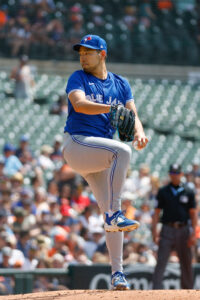The 54-42 Twins enter the second half of the 2024 season sitting a dozen games over .500 and in possession of the second Wild Card spot in the American League. After falling behind both the Guardians and Royals early in the year, they’ve leapfrogged Kansas City (54-45) and sit a manageable four and a half games back of Cleveland (58-37) for the division lead. They’re lining up to act as clear buyers at the deadline, and Dan Hayes of The Athletic reports that Minnesota would like to add another arm in the rotation — likely a rental.
Adding a starter who’s only controlled through season’s end is sensible for the Twins but a departure from the types of rotation arms they’ve targeted at recent trade efforts. It’s worth remembering that Twins ownership slashed payroll meaningfully this past offseason, cutting down from 2023’s mark of around $155MM to this season’s Opening Day mark of about $127.5MM. That came amid uncertainty regarding the future of the Twins’ television contract with Bally Sports, and given that the eventual resolution was a one-year deal to remain with Bally, it’s not surprising that the club might prefer to avoid committing substantial salary to the 2025 books in the form of acquiring a more controllable arm. (Although to be clear, there’s no indication ownership would be staunchly opposed to adding to the ’25 books.)
A short-term stopgap in the rotation is sensible for reasons beyond the 2025 payroll, of course. The Twins could currently use some extra innings in the back half of the rotation, where Chris Paddack has had an inconsistent season as he pushes his workload back to levels he hasn’t seen since 2019 in what is his first season back from a second career Tommy John surgery. Rookie right-hander Simeon Woods Richardson has enjoyed a breakout year but is 23 innings shy of last season’s total of 118 1/3 innings. Bringing in a veteran arm would offer some stability behind the staff-leading trio of Pablo Lopez, Joe Ryan and Bailey Ober.
Adding to the appeal of a rental, the Twins’ entire slate of 2024 rotation options is controlled/signed beyond the current season. Lopez is signed through 2027. Ryan and Ober are controllable via arbitration through that same year. Paddack is signed through 2025 and presumably won’t have as many workload concerns next year. Woods Richardson can’t reach free agency until the 2030-31 offseason.
The organization’s top two pitching prospects, David Festa and Zebby Matthews, are both in the upper minors and could be in the mix for starts next year as well. (Festa has already made his MLB debut in 2024, though he’s been hit hard in a pair of spot starts.) That doesn’t even include hometown righty Louie Varland, who opened the season as the Twins’ fifth starter but has fallen behind Woods Richardson and Festa on the depth chart. He’s still starting in Triple-A for now, but there’s been plenty of speculation about an eventual move to the bullpen for the former top prospect.
Hayes lists Toronto lefty Yusei Kikuchi as one name the Twins “could” target, though it’s not clear just yet whether the two parties have had any meaningful discussions about the southpaw. Kikuchi is in the final season of a three-year, $36MM contract and is widely expected to be traded, with the Jays buried by 14 games in the AL East and only sitting marginally better in the Wild Card hunt (nine and a half games out).
The 33-year-old Kikuchi has logged 106 innings of 4.42 ERA ball with a sharp 26% strikeout rate and excellent 5.8% walk rate that belie his pedestrian earned run average. After a tough first season in Toronto, he’s proven to be a solid pickup in years two and three of the deal, thanks in large part to his revamped curveball. That said, he’s hit a rough patch of late, stumbling to a 6.00 ERA in his past nine starts (45 innings). His strikeout and walk rates have remained excellent, but a longstanding issue with home runs has once again reared its head; Kikuchi has been tagged for 11 round-trippers in that time (2.2 HR/9).
Detroit’s Jack Flaherty is the most highly regarded rental arm likely to be on the market, though he’d likely command a prospect of note and the Twins might balk at sending a touted farmhand to a division rival. Washington’s Trevor Williams would be among the more clearly available rental arms on the market were it not a for a flexor strain that’s sidelined him since late May. There are a number of potential rental arms who could hit the market in the days ahead, depending on how their respective teams play. The Reds (Frankie Montas), Rangers (Michael Lorenzen, Andrew Heaney), Pirates (Marco Gonzales, old friend Martin Perez) and Giants (Alex Cobb) are all within five games of a playoff spot but could make some sell-side moves if they fall into a losing streak coming out of the break.
